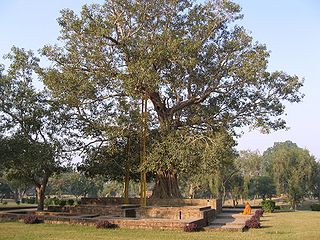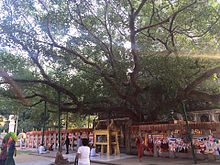
Ficus is a genus of about 850 species of woody trees, shrubs, vines, epiphytes and hemiepiphytes in the family Moraceae. Collectively known as fig trees or figs, they are native throughout the tropics with a few species extending into the semi-warm temperate zone. The common fig (F. carica) is a temperate species native to southwest Asia and the Mediterranean region, which has been widely cultivated from ancient times for its fruit, also referred to as figs. The fruit of most other species are also edible though they are usually of only local economic importance or eaten as bushfood. However, they are extremely important food resources for wildlife. Figs are also of considerable cultural importance throughout the tropics, both as objects of worship and for their many practical uses.

The Bodhi Tree, also called the Mahabodhi Tree, Bo Tree, is a large sacred fig tree located in Bodh Gaya, Bihar, India. Siddhartha Gautama, the spiritual teacher who became known as the Buddha, is said to have attained enlightenment or buddhahood circa 500 BCE under this tree. In religious iconography, the Bodhi Tree is recognizable by its heart-shaped leaves, which are usually prominently displayed.

A banyan, also spelled banian, is a fig that develops accessory trunks from adjacent prop roots, allowing the tree to spread outwards indefinitely. This distinguishes banyans from other trees with a strangler habit that begin life as an epiphyte, i.e. a plant that grows on another plant, when its seed germinates in a crack or crevice of a host tree or edifice. "Banyan" often specifically denotes Ficus benghalensis, which is the national tree of India, though the name has also been generalized to denominate all figs that share a common life cycle and used systematically in taxonomy to denominate the subgenus Urostigma.

Ficus benghalensis, or Ficus indica commonly known as the banyan, banyan fig and Indian banyan, is a tree native to the Indian Subcontinent. Specimens in India are among the largest trees in the world by canopy coverage. It is also known as the "strangler fig" because it starts out as epiphyte, that is, leaning on another tree that it ends up suffocating.

Ficus benjamina, commonly known as weeping fig, benjamin fig or ficus tree, and often sold in stores as just ficus, is a species of flowering plant in the family Moraceae, native to Asia and Australia. It is the official tree of Bangkok. The species is also naturalized in the West Indies and in the states of Florida and Arizona in the United States. It is one of the most common trees in Israeli cities and parks. In its native range, its small fruit are favored by some birds.

Ficus microcarpa, also known as Chinese banyan, Malayan banyan, Indian laurel, curtain fig, or gajumaru (ガジュマル), is a tree in the fig family Moraceae. It is native in a range from China through tropical Asia and the Caroline Islands to Australia. It is widely planted as a shade tree and frequently misidentified as F. retusa or as F. nitida.

Ficus elastica, the rubber fig, rubber bush, rubber tree, rubber plant, or Indian rubber bush, Indian rubber tree, is a species of flowering plant in the family Moraceae, native to eastern parts of South and Southeast Asia. It has become naturalized in Sri Lanka, the West Indies, and the US state of Florida. Despite its common names, it is not used in the commercial production of natural rubber.

Ficus sycomorus, called the sycamore fig or the fig-mulberry, sycamore, or sycomore, is a fig species that has been cultivated since ancient times.

According to Hindu scriptures, Aśvattha, or Sacred fig, is a sacred tree for the Hindus and has been extensively mentioned in texts pertaining to Hinduism, for example as peepul in Rig Veda mantra I.164.20. In Buddhism, the Bodhi Tree under which Gautama Buddha gained enlightenment is also of the same species.

Ficus racemosa, the cluster fig, red river fig or gular, is a species of plant in the family Moraceae. It is native to Australia and tropical Asia. It is a fast-growing plant with large, very rough leaves, usually attaining the size of a large shrub, although older specimens can grow quite large and gnarled. It is unusual in that its figs grow on or close to the tree trunk, termed cauliflory.

Ficus lyrata, commonly known as the fiddle-leaf fig, banjo fig, fiddle-leaved fig tree, lyre leaf fig tree, or lyre-leaved fig tree, is a species of plant in the mulberry and fig family Moraceae. It is native to western Africa, but is cultivated around the world as an ornamental plant. It has received the Royal Horticultural Society's Award of Garden Merit.

A sacred tree or holy tree is a tree which is considered to be sacred, or worthy of spiritual respect or reverence. Such trees appear throughout world history in various cultures including the ancient Hindu mythology, Greek, Celtic and Germanic mythologies. They also continue to hold profound meaning in contemporary culture in places like Japan (shinboku), Korea, India, and the Philippines, among others. Tree worship is core part of religions which include aspects of animism as core elements of their belief, which is the eco-friendly belief that trees, forests, rivers, mountains, etc have a life force and need to be conserved and used in a sustainable manner.
Panchavati is an ancient holy city in Nasik, Maharashtra, India; the place of vanavasa (banishment) of Rama in the ancient Indian epic Ramayana.

In Buddhism, udumbara refers to the tree, flower and fruit of the Ficus racemosa. In Buddhist literature, this tree or its fruit may carry the connotation of rarity and parasitism. It is also mentioned in Vedic texts as the source of wood for rituals and amulets.

The fig is the edible fruit of Ficus carica, a species of small tree in the flowering plant family Moraceae, native to the Mediterranean region, together with western and southern Asia. It has been cultivated since ancient times and is now widely grown throughout the world. Ficus carica is the type species of the genus Ficus, containing over 800 tropical and subtropical plant species.

Ficus sur, with the common names Cape fig and broom cluster fig, is a widespread Afrotropical species of cauliflorous fig.

The Ficus sansibarica, known as knobbly fig, is an African species of cauliflorous fig. It is named after Zanzibar, where Franz Stuhlmann discovered it in 1889. They often begin life as epiphytes, which assume a strangling habit as they develop. They regularly reach 10 m, but may grow up to 40 m tall as forest stranglers.
The Ch. Devi Lal Rudraksh Vatika Herbal Nature Park, in short Rudraksh Vatika, is a 184 acre forested wildlife area, wetland and herbal park for the conservation of biodiversity of over 400 endangered ayurvedic medicinal herbs in Shivalik foothills of Himalayas. It is located on the western bank of Western Yamuna Canal, 1.3 km east of NH-907, in Chuharpur Kalan village of Yamunanagar district of Haryana state in India.
Ficus amplissima, also known as the Indian bat tree, Indian bat fig, Pimpri, Pipri (Piparee), Pipali or Bilibasari mara is a tree species of flowering plants that belongs to Moraceae, the fig or mulberry family. It is native to Central and southern Peninsular India, Sri Lanka and Maldives, having a significant distribution throughout Western Ghats of India. It is most commonly planted to provide shade in coffee plantations due to its dense and wide foliage. The ripened figs attract many birds, especially during the spring.

The sacred groves is a zone of Biodiversity Park, Visakhapatnam located in the premises of Rani Chandramani Devi Government Hospital. It has more than 100 sacred plant species, which are medicinal herbs with religious importance. Many sacred plants are becoming rare and endangered. Hence they are to be reared, protected, and conserved. The zone was inaugurated on February 5, 2017, by Kambhampati Hari Babu, a member of parliament from Visakhapatnam, Andhra Pradesh.







![Typical example of aerial roots aa[?]mrN 01.JPG](http://upload.wikimedia.org/wikipedia/commons/thumb/d/d4/%E0%B4%86%E0%B5%BD%E0%B4%AE%E0%B4%B0%E0%B4%82_01.JPG/220px-%E0%B4%86%E0%B5%BD%E0%B4%AE%E0%B4%B0%E0%B4%82_01.JPG)
















